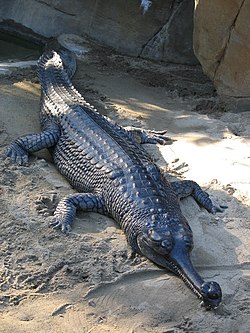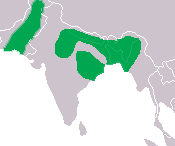Gharial - Simple English Wikipedia, the free encyclopedia
| Gharial | |
|---|---|
 | |
| Scientific classification | |
| Kingdom: | |
| Class: | |
| Order: | |
| Family: | |
| Genus: | |
| Binomial name | |
| Gavialis gangeticus | |
The gharial (Gavialis gangeticus), sometimes called the Indian gharial, common gharial or gavial, is one of two surviving members of the family Gavialidae. They are a group of crocodile-like reptiles with long, narrow jaws.
The gharial is the second-longest of all living crocodilians: a large male can be nearly six meters in length. Only saltwater crocodiles and the Nile crocodile can grow larger.[1]
Ancestry
[change | change source]The fossil history of the Gavialoidea is quite well known. The earliest examples split from the other crocodilians in the late Cretaceous. The feature of the group that is easiest to recognise is the very long, narrow snout. This is an adaptation to a diet of small fish. Gharials have sacrificed the great mechanical strength of the robust skull and jaw that most crocodiles and alligators have. For this reason, and they cannot prey on large creatures. But they also have reduced weight and water resistance of their lighter skull and very narrow jaw. This gives gharials the ability to catch rapidly moving fish. They catch them with a side-to-side snapping motion.
The earliest Gavialoidea may or may not have been related to the modern types: some died out at the same time as the dinosaurs (at the end of the Cretaceous), others survived until the early Eocene (about 35 million years ago). The modern forms appeared at much the same time. They evolved in the estuaries and coastal waters of Africa. They crossed the Atlantic to reach South America as well. At their peak, the Gavialoidea were numerous and diverse, they occupied much of Asia and America up until the Pliocene. One species, Rhamphosuchus crassidens of India, is believed to have grown to an enormous 15 metres or more.
Distribution
[change | change source]
Northern Indian subcontinent: Bhutan (almost extinct), Bangladesh (close to extinction), India (present in small numbers and increasing), Myanmar (possibly extinct), Nepal, Pakistan (close to extinction). Usually found in the river systems of Indus (Pakistan) and the Brahmaputra (Bangladesh, Bhutan & North eastern India), the Ganges (Bangladesh, India & Nepal), and the Mahanadi River (in the rainforest biome) (India). Small numbers are in Kaladan and the Ayeyarwady in Myanmar. It is sympatric, in respective areas, with the mugger crocodile (Crocodylus palustris) and the saltwater crocodile (Crocodylus porosus).
Habitat
[change | change source]Gharials live in rivers. They are best adapted to the calmer areas in deep fast moving rivers. Their physical attributes do not make the animals very suited to walk on land. In fact the only reasons the gharial leaves the water is to either bask in the sun or to nest on the sandbanks of the rivers.
Appearance
[change | change source]The Gharial has a long, narrow snout. This is the feature that is most different from most other Crocodilia. The only other species who has such a snout is the False gharial (Tomistoma schlegelii), which is closely related. The shape of this snout changes when the animal grows older. The snout becomes progressively thinner the older the gharial gets. There is a bulbous growth on the tip of the male's snout. This is called a 'ghara' (after the Indian word meaning 'pot'). It is only present in mature animals. It is used for different activities, such as making a resonant hum during vocalization. It is also used for attracting females. The mating ritual includes a section where the male uses this ghara to make bubbles.


The long jaws are lined with many interlocking, razor-sharp teeth. This is an adaptation to the diet (predominantly fish in adults). This species is one of the largest of all crocodilian species, approaching the saltwater crocodile (Crocodylus porosus) and the Nile crocodile in maximum size - males reach at least 5 metres in length, and often approach 6 metres. Reports of 7 metre animals exist, but are unconfirmed. The leg musculature of the gharial is not suited to enable the animal to raise the body off the ground (on land) in order to achieve the high-walk gait - being able only to push its body forward across the ground ('belly-sliding'), although it can do this with some speed when required. However, when in water, the gharial is the most nimble and quick of all the crocodiles in the world. The tail seems overdeveloped and is flattened on the side, more so than other crocodiles. This enables it to achieve the excellent swimming abilities.
The gharial has 27 to 29 upper and 25 or 26 lower teeth on each side. These teeth are not received into interdental pits; the first, second, and third mandibular teeth fit into notches in the upper jaw. The front teeth are the largest. The gharial's snout is narrow and long, with a dilation at the end and its nasal bones are comparatively short and are widely separated from the pre-maxillaries. The nasal opening of a gharial is smaller than the supra-temporal fossae. The gharial's lower anterior margin of orbit (jugal) is raised and its mandibular symphysis is extremely long, extending to the 23rd or 24th tooth. A dorsal shield is formed from four longitudinal series of juxtaposed, keeled and bony scutes.[2]
The length of the snout is 3.5 (in adults) to 5.5 times (in young) the breadth of the snout's base. Nuchal and dorsal scutes form a single continuous shield composed of 21 or 22 transverse series. Gharials have an outer row of soft, smooth or feebly-keeled scutes in addition to the bony dorsal scutes. They also have two small post-occipital scutes.
The outer toes of a gharial are two-thirds webbed, while the middle toe is one-third webbed. Gharials have a strong crest on the outer edge of the forearm, leg and foot. Typically, adult gharials are of a dark olive hue while young ones are pale olive, with dark brown spots or cross-bands.[2]
Diet
[change | change source]Young gharials eat insects, larvae, and small frogs. Adults feed almost only on fish, although some individuals have been known to eat dead animals. Their snout morphology is ideally suited for piscivory; their long, narrow snouts afford very little resistance to water in swiping motions to snap up fish in the water. Their numerous needle-like teeth are perfect for holding on to struggling, slippery fish.
Danger to humans
[change | change source]The Gharial is not a man-eater. Despite its immense size, its thin, fragile jaws make it physically incapable of devouring any large animal, including a human being. The myth that gharials eat humans may come partly from their similar appearance to crocodiles and because jewelry has been found in the digestive system. However, the gharial may have swallowed this jewelry while scavenging corpses or because used to aid digestion or buoyancy management.
Breeding
[change | change source]The mating season is during November through December and well into January. The nesting and laying of eggs takes place in the dry season of March, April, and May. This is because during the dry season the rivers shrink a bit and the sandy river banks are available for nesting. Between 30 and 50 eggs are deposited into the hole that the female digs up before it is covered over carefully. After about 90 days, the juveniles emerge, although there is no record of the female assisting the juveniles into the water after they hatch (probably because their jaws are not suited for carrying the young due to the needle like teeth). However the mother does protect the young in the water for a few days till they learn to fend for themselves.
Conservation
[change | change source]In the 1970s the gharial came to the brink of extinction and even now remains on the critically endangered list. The conservation efforts of the environmentalists in cooperation with several governments has led to some reduction in the threat of extinction. Some hope lies with the conservation and management programs in place as of 2004. Full protection was granted in the 1970s in the hope of reducing poaching losses, although these measures were slow to be implemented at first. Now there are 9 protected areas for this species in India which are linked to both captive breeding and 'ranching' operations where eggs collected from the wild are raised in captivity (to reduce mortality due to natural predators) and then released back into the wild (the first being released in 1981). More than 3000 animals have been released through these programs, and the wild population in India is estimated at around 1500 animals - with perhaps between one and two hundred animals in the remainder of its range.
Recently this species has moved from Endangered to Critically Endangered on the 2007 Red List of endangered species of animals and plants issued by the World Conservation Union, and qualifies for protection under the CITES (Convention on International Trade of Endangered Species) Appendix II.[3][4]
Taxonomy
[change | change source]The gharial and its extinct relatives are grouped together by taxonomists in several different ways:
- If the three surviving groups of crocodilians are regarded as separate families, then the gharial becomes one of two members of the Gavialidae, which is related to the families Crocodylidae (crocodiles) and Alligatoridae (alligators and caymans).
- Alternatively, the three groups are all classed together as the family Crocodylidae, but belong to the subfamilies Gavialinae, Crocodylinae, and Alligatorinae.
- Finally, palaentologists tend to speak of the broad lineage of gharial-like creatures over time using the term Gavialoidea.
Janke et al. (2005), using molecular genetic evidence, found the gharial and the false gharial (Tomistoma) to be close relatives, and placed them together in the same family.
Common names include: Indian gharial, Indian gavial, Fish-eating crocodile, Gavial del Ganges, Gavial du Gange, Long-nosed crocodile, Bahsoolia, Nakar, Chimpta, Lamthora, Mecho Kumhir, Naka, Nakar, Shormon, Thantia, Thondre, Garial.
Classification
[change | change source]- Order Crocodilia
- Superfamily Gavialoidea
- Family Gavialidae
- Superfamily Gavialoidea
Related pages
[change | change source]References
[change | change source]- ↑ Crocodilian species - Gharial
- ↑ 2.0 2.1 Boulenger, G. A. 1890. Fauna of British India. Reptilia and Batrachia.
- ↑ "Choudhury, B.C., Singh, L.A.K., Rao, R.J., Basu, D., Sharma, R.K., Hussain, S.A., Andrews, H.V., Whitaker, N., Whitaker, R., Lenin, J., Maskey, T., Cadi, A., Rashid, S.M.A., Choudhury, A.A., Dahal, B., Win Ko Ko, U., Thorbjarnarson, J & Ross, J.P. 2007. Gavialis gangeticus. In: IUCN 2007. 2007 IUCN Red List of Threatened Species. <www.iucnredlist.org>>". Archived from the original on 2007-12-25. Retrieved 2007-12-15.
- ↑ “At 200, gharials now on critically-endangered list” by Neelam Raaj, TNN, The Times of India, 13 Sep 2007
- Crocodile Specialist Group (1996). Gavialis gangeticus. 2006 IUCN Red List of Threatened Species. IUCN 2006. Retrieved on 11 May 2006. Listed as Endangered (EN C2a, E v2.3)
- Janke A, Gullberg A, Hughes S, Aggarwal RK, Arnason U. (2005). "Mitogenomic analyses place the gharial (Gavialis gangeticus) on the crocodile tree and provide pre-K/T divergence times for most crocodilians." J Mol Evol. 61(5):620-6.
Other websites
[change | change source]- http://reptilis.net/crocodylia/gavies/gavialidae.html a less formal article, great photos
- http://www.vic.com/nepal/images/gharial.html Archived 2007-09-27 at the Wayback Machine photo of a large specimen in the wild
- http://www.flmnh.ufl.edu/cnhc/!ggan1.htm teeth and feeding
- http://www.whozoo.org/students/lydia/gharials.htm excellent photos from Fort Worth Zoo
- http://www.oneworldmagazine.org/tales/crocs/gharial.html Archived 2017-03-25 at the Wayback Machine a charming folk tale
- http://www.scz.org/animals/g/gharial.html Archived 2007-09-29 at the Wayback Machine species summary from Sedgwick County Zoo
- http://www.itis.usda.gov Archived 2006-02-17 at the Wayback Machine ITIS Taxonomic Serial No.: 202217


 French
French Deutsch
Deutsch